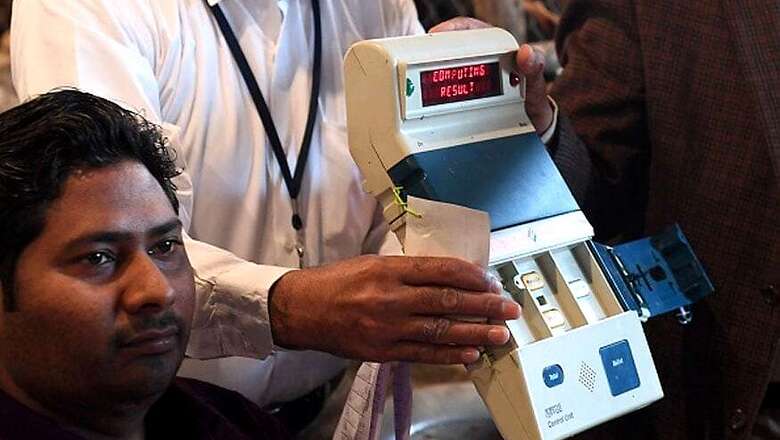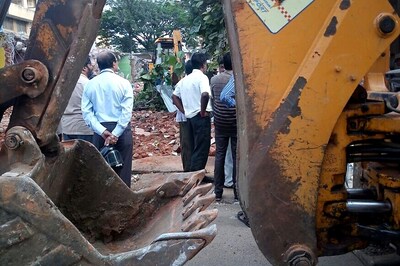
views
At a time when the credibility of the electronic voting machines is one of the most hotly debated topics of the country, the Election Commission has come forward to restore the credibility of the machines.
Not only have they called for an all-party meeting and hinted at a possible hackathon, the Commission has also released the story of these EVMs in India.
Here is all that you want to know about this ever so debated machines.
Where are the EVMs made?
EVMs and VVPATs are manufactured by Bharat Electronics Limited (PSU under Ministry of Defence, Govt. of India) and Electronics Corporation of India Limited (PSU under the Department of Atomic Energy, Govt. of India). The software of EVMs is developed in-house by a selected group of Engineers in BEL and ECIL independently from each other.
This select software development group of few engineers design and develop the source code. After completion of software development, testing and evaluation of the software is carried out by another independent testing group in the PSUs as per the software requirements specifications (SRS). This ensures that the software has been written as per the requirements laid down for its intended use only.
In M1 and M2 EVMs machine code compiled from source programme code was given to the micro controller manufacturer for writing in ONE TIME PROGRAMMABLE (OTP) micro controllers. From this machine code, the exact original source code cannot be read. For such OTP microcontrollers, the code once programmed cannot be modified and cannot be read by any means.
Now technological advancements permit writing of machine code into the chips at PSU premises, hence in M3 (post 2013) EVMs, the program is burnt into the chip at PSU premises itself. Due to absence of requisite facilities to produce microcontrollers in India, these are procured from manufacturers abroad.
Up on receipt of machine code, the micro controller manufacturer verifies against any modifications during transit and programs this code in the micro controller in the OTP area and initially provides engineering samples of programmed chip to PSUs for evaluation.
These samples are then assembled into the EVM, evaluated and verified for authenticity of code and functionality at great length. Bulk production clearance by PSU is given to micro controller manufacturer only after successful completion of this verification.
EVM Tracking Software (ETS)
The Election Commission has introduced ETS as a modern inventory management system where the identity and physical presence of all EVMS/VVPATs is tracked on real time basis by the Election Commission of India and any movement of these machines ordered by ECI has to mandatorily be through this system
Comparison to the electoral processes in other countries:
The marriage between technology and election management goes back to at least 1892, when the first ‘lever voting machine’ was used in New York after using the paper ballot for a long time. In the 1960s, punch-card machines were introduced in the USA, and the first EVM was introduced there in 1975. Electronic Voting has moved quite ahead since then.
Netherlands
Electronic Voting machine was used in The Netherlands in between 1990-2007. The voting machines were manufactured by a private Dutch-company called NEDAP (Nederlandse Apparaten Fabriek NV). In 2006, the government ordered an independent testing of the voting machines.
Two independent commissions, The Voting Machines Decision-making Commission and the Election Process Advisory Commission (EPAC) were also established on December 19, 2006 and January 18, 2007, respectively, to review the security and reliability features of NEDAP machines. Following the observations of the two Commissions, the use of NEDAP machines and electronic voting was discontinued in 2007 on the following grounds:
Technology vendors became part of the decision making process and the ministry was not in a position to exercise effective oversight.
The Dutch Organization for Applied Scientific Research (Toegepast Natuurwetenschappelijk Onderzoek, TNO) certified and tested these machines following “outdated standards” which were not immune to modern IT and security threats. Moreover, the certification and testing reports were not made public depriving independent experts to verify the analysis.
The legal framework, particularly the necessary security requirements, was inadequate to deal with the specificities of the electronic voting process.
Germany
In Germany, the e-voting machines manufactured by NEDAP were used in between 2005–2009 before it came under criticism and finally discontinued. The Bundesverfassungsgericht (the Federal Constitutional Court of Germany) ordered the discontinuation of the use of NEDAP machines in 2009 because of the following reasons:
The use of Nedap electronic voting machines violated the principle of the public nature of elections (Article 38 in conjunction with Article 20.1 and 20.2 of the Basic Law) that requires that all essential steps in the elections are subject to public examinability unless other constitutional interests justify an exception.
It also observed that “it must be possible for the citizen to check the essential steps in the election act and in the ascertainment of the results reliably and without special expert knowledge”.
Ireland
NEDAP machines were used in Ireland in between 2002–2004. The use of these machines was questioned following which two independent commissions were set up. The two Commissions on the Secrecy, Accuracy and Testing of the Chosen Electronic Voting System, concluded the NEDAP machines could not be used in elections in Ireland on the following grounds:
*Inadequate technological safeguards
*Insecure transfer of data by the use of CDs
*Absence of a comprehensive independent end-to-end testing, verification and *certification by a single accredited body. Inconsistencies in physical security of machines across constituencies
*Absence of a clear policy guideline via-a-vis storage, transport, set-up, use and disposal of voting equipment
*Absence of comprehensive electronic register to record the identity, location and movement of the electronic voting devices.
United States of America
In 2000, after the dispute on the voting method in the USA presidential elections, the voting method was reviewed. Accordingly, Direct Recording Electronic (DRE) Systems (like the widely used AccuVote TS developed by Premier Election Solutions, commonly called Diebold) were introduced. DRE Systems uses “one of three basic interfaces (pushbutton, touchscreen or dial)” through which “voters record their votes directly into computer memory. The voter’s choices are stored in DREs via a memory cartridge, diskette or smart card…Some DREs can be equipped with Voter Verified Paper Audit Trail (VVPAT) printers...” Currently, in the USA, the Direct Recording Machines are used in 27 states, among which paper audit trails are used in 15 states. The other voting methods include: Optical Scan Paper Ballot Systems, Ballot Marking Devices, and the Punch Card Ballot.
How are Indian EVMS different?
Indian EVMs are truly unique compared to the e-voting machines used in other parts of the world for the following reasons:
*ECI-EVMs are stand-alone non-networked machines
*ECI-EVMs have been time and again successfully verified and certified by an independent Technical Experts Committee after an end-to-end testing process. STQC under Ministry of Information and Technology, an accredited third party entity, conducts standardization and certification of ECI EVMs produced by manufacturers, unlike the machines used in Netherlands.
*Every EVM has a unique number attached to it, which is recorded in the Election Commission’s database through EVM Tracking Software. This number of the EVM can always be cross-checked against the database.
*The software used in these EVMs is One Time Programmable (OTP), which can’t be re-written after manufacture.




















Comments
0 comment